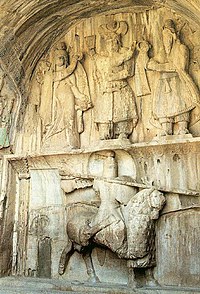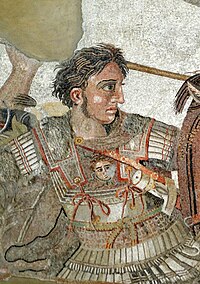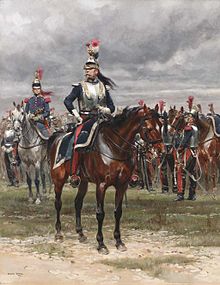Heavy cavalry



Heavy cavalry was a class of
History of heavy cavalry
This section may be too long to read and navigate comfortably. (October 2019) |
Persians

Iranian tribes such as the Massagetae were believed to be the originator of the class of heavy cavalry known as cataphract. During the time of Achaemenid Persia cavalry was the elite arm of service (as was the case in most civilizations), and many Persian horsemen such as the bodyguard unit of Cyrus the Younger were rather heavily armoured by the standards of the era. By the time of Alexander's invasion cataphract units with both men and beasts being fully encased in armour were already in use by the Persians.
The
All their companies clad in iron, and all parts of their bodies were covered with thick plates, so fitted that the stiff joints conformed with those of their limbs; and forms of the human faces were so skillfully fitted to their heads, that since their entire bodies were covered with metal, arrows that fell upon them could lodge only where they could see a little through tiny openings opposite the pupil of the eye, or where through the tips of their noses they were able to get a little breath. The Persians opposed us serried bands of mail-clad horsemen in such close order that the gleam of moving bodies covered with closely fitting plates of iron dazzled the eyes of those who looked upon them, while the whole throng of horses was protected by coverings of leather.
Western Europeans
The
The small size of Celtic horses meant that the Celtic heavy cavalry of north-western and central Europe appear to have been employed as heavy skirmisher cavalry, rather than the shock cavalry of the Middle East and North Africa, the heavy cavalry of Gaul and Celtiberia being widely regarded as some of the finest horsemen of the ancient world. The Gauls were known to be able to hurl their javelins while retreating, and to use a system whereby a cavalryman was supported by two other men with fresh horses who could resupply him with missiles. For close combat the main weapon was the spear, around 7 feet (2.1 m) in length with a leaf-bladed head, and a heavy wooden shield with an iron spindle-type boss. The most prestigious weapon was the sword, a blade ranging anywhere from 2 to 3 feet (0.61 to 0.91 m) in length. Celtic swords were typically of good quality, with some being of such quality that archeologists have classed them as being equal to modern, high-quality steel replicas.
The heavy cavalry of the Celtiberi, widely employed by the Carthaginians, included men who may have ridden on mail-armoured horses. Known to the Romans as "Lanciarii" (not to be confused with the spear-armed infantry of the Eastern Roman Empire), they are represented in several Iberian carvings of the period. They may have carried the "soliferrum", the all-iron javelin unique to Iberia, in addition to a spear and shield and a Celtic-style longsword or an Iberian falcata. Together with the Gallic nobles, it was likely these horsemen who at the Battle of Cannae charged and then broke the Roman and Italian cavalry.
Greeks

The ancient Greeks called armoured cavalry Kataphraktos (pl. Kataphraktoi) which translated means roughly "covered, protected" or "armoured". The term was later borrowed by the Romans (the Latin variant in the Roman Empire being Cataphractarii) and until the Middle Ages in Europe, continued to be used to designate armoured cavalry. However, as with other types of cavalry, heavy cavalry was not employed in any significant capacity in wars between the Greek city states until later, mainly due to the prevalence of hoplite warfare as well as the mountainous terrain of Central Greece. The lack of suitable grassland and excess grain supply necessary for the production of good cavalry mounts was also crippling to the establishment of an effective cavalry force, the noted Greek mercenary and writer Xenophon once saying that a horse farm was the most expensive type of establishment to keep running.
The exception was in
The development of the
In the aftermath of the
Middle Ages

Advent of the stirrup
The stirrup, which gives greater stability to a rider, has been described as one of the most significant inventions in the history of warfare, prior to the use of gunpowder. As a tool allowing expanded use of horses in warfare, the stirrup is often called the third revolutionary step in equipment, after the chariot and the saddle. The basic tactics of mounted warfare were significantly altered by the stirrup. A rider supported by stirrups was less likely to fall off while fighting, and could deliver a blow with a weapon that more fully employed the weight and momentum of horse and rider. Among other advantages, stirrups provided greater balance and support to the rider, which allowed the knight to use a sword more efficiently without falling, especially against infantry adversaries.
The metal stirrup was invented in 4th century China, that the stirrup was responsible for the development of feudalism, though this is not fully accepted.
Cataphracts
Contemporary depictions however imply that they were not as completely armoured as earlier Roman and Sassanid types—horse armour is noticeably absent. Byzantine cataphracts of the 10th century were drawn from the ranks of the middle class landowners through the theme system, providing the Byzantine Empire with a motivated and professional force. An experimental type of cataphract was brought to the fore in the 10th and 11th centuries known as the klibanaphoros, "bearer of klibanion"—named after the clibanarius and a throwback to the very heavily armoured cavalry of earlier days. However, the traditional view is that after the loss of prestige, men and material and the horse-rearing plains of Anatolia after they lost the decisive Battle of Manzikert to lighter Turk cavalry, they slowly dropped out of use.
But according to J. Birkenmeier in "The development of the Komnenian army: 1081–1180", units of 'Kataphraktoi' (cataphracts) were still being used during the 12th century. The
It is difficult to determine when exactly the cataphract saw his final day in battle. After all, both cataphracts and knights fulfilled a similar role on the medieval battlefield, and the armoured knight survived well into the modern age. The Byzantines called all heavy shock cavalry kataphraktoi.
The Byzantine army maintained units of heavily armoured cavalrymen up to its last years, while neighbouring
Knights

In the early Middle Ages, the rank of knight was loosely defined. In late
From the 12th century onwards, the term became associated to
Knighthood was a
Africa and Asia

The Heavy cavalry of the Oyo Empire located in what are now Nigeria and Benin entailed cavalrymen armed with heavy thrusting spears and swords and protected by mail armor. Selected horses were larger imported horses from other neighbouring kingdoms.[13]
In China, heavy cavalry was developed during the Han dynasty (202 BC–220 AD),[14] with armoured lancers becoming widespread during the Western Han era. Armoured cavalry, with both soldier and steed clad in complete armour, were employed in the late Han dynasty, and became widespread in the 4th century AD, where it was the main striking force of the armies of the Northern dynasties of China (4th century to 6th century.) During the Tang dynasty (618–907) the importance of infantry and lighter-armed cavalry and infantry increased while that of the armoured cavalry decreased, with horse armour seldom used. However, armoured cavalry were again used by the Song dynasty (960–1279) and its enemies, including the Jin, Xi Xia, Mongols, and Khitans.
In Korea, the earliest evidence of armoured cavalry is a mid-4th century AD
Renaissance to 20th century

Armoured cavalry, in the form of the gendarme, was at its highest as a proportion of the total number of combatants in many Renaissance armies, especially in France. Other Western European states also used heavy cavalry very often, such as Spain and the Holy Roman Empire in the Italian Wars.
Central and Eastern Europe saw the emergence of
Two particular types of European heavy cavalry typical of the 16th century and the first half of the 17th century were (i) the Reiter - a form of early cuirassier in half or three-quarters plate armor, armed primarily with a straight-bladed, double-edged one-handed sword (an evolution of the medieval arming sword) and a rider pistol (the first pistol firearms having been invented in the 16th century), or (ii) the demi-lancer - an armoured lancer wearing three-quarters plate armor that continued the mounted man-at-arms lancer traditions established in the late Middle Ages (e.g. in the 15 century). The Polish-Lithuanian winged hussars and the Hungarian armoured hussars-lancers that inspired the winged hussars represented a central and eastern European counterpart to the demi-lancer, serving similar tactical roles on 16th and 17th century battlefields.
Thirty Years' War

Cuirassiers played a very large role in the
After the Thirty Years' War

The heavy cavalry's use of plate armor covering most of the body greatly diminished after the Thirty Year's War. Cuirassiers transitioned to using only a helmet and an enclosed cuirass. In the latter half of the 17th century, most European lancers abandoned the use of armor aside from a helmet, and occasionally a cuirass. European lancers from the 18th century onward were unarmoured light cavalry. Some of the 17th century heavy cavalry also wore a pauncer, a front-only cuirass without a backplate, instead of a full cuirass, as well as a helmet.
By 1705, the Holy Roman Emperor's personal forces in Austria included twenty cuirassier regiments. Imperial
Cuirassiers played a prominent role in the armies of
Given the increased bullet velocity and accuracy of 19th century firearms, already during the Napoleonic era, the cuirass of the cuirassers of the time was intended primarily as protection from melee attacks (bayonet thrusts, sabre cuts, etc.), rather than from enemy
Apache Wars
From roughly 1650 to 1820,
.Modern era
The last time cavalry of both belligerents wore cuirasses in battle was during the Franco-Prussian War. The Imperial German and Russian cuirassiers subsequently discarded this armour for all but parade purposes, but the twelve regiments of French heavy cavalry still in existence in 1914 wore their cuirasses on active service during the opening stages of World War I.[17] Although some heavy cavalry regiments have remained into the 21st century, their large mounts are today used solely for ceremonial duties, such as those of the Household Cavalry in the United Kingdom.
Today, armoured fighting vehicles such as the tank fills the niche of heavy cavalry.
See also
References and notes
- ^ p.490, Lynn
- ^ Carey, Allfree and Cairns, pp. 65-66
- ^ Diodorus Siculus, Arrian
- ^ a b "China, Buddhism and the Silk Road – Silk-Road.com". Silk Road. Retrieved 2019-06-27.
- ^ "FindArticles.com | CBSi". www.findarticles.com. Retrieved 2019-06-27.
- ^ "The invention and influences of stirrup" Archived December 3, 2008, at the Wayback Machine
- ^ See George T. Dennis (ed.), Maurice's Strategikon, p. XVI; for contrary views, Lynn White, Jr., Medieval Technology and Social Change, Oxford University Press, 1964, notes, p. 144.
- ISBN 978-9-00-416389-8.
- ^ Curta p.315
- ^ Nelson, Ken (2015). "Middle Ages: History of the Medieval Knight". Ducksters. Technological Solutions, Inc. (TSI).
- ^ Saul, Nigel (September 6, 2011). "Knighthood As It Was, Not As We Wish It Were". Origins.
- ^ Freudenrich, Craig (January 22, 2008). "How Knights Work". How Stuff Works.
- ^ Smith 1989, p. 48.
- ^ "复活的军团". YouTube.[dead YouTube link]
- ISBN 0-691-02475-8.
- ISBN 978-0-85045-798-8. Retrieved 28 October 2010.
- ISBN 0-09-180178-8
Sources
- Carey, B.T., Allfree, J. and Cairns, J. (2006) Warfare in the Ancient World, Pen and Sword, Barnsley ISBN 9781783370689
- Lazaris, Stavros (dir.), Le cheval dans les sociétés antiques et médiévales. Actes des Journées internationales d'étude (Strasbourg, 6-7 novembre 2009), Turnhout: Brepols, 2012, https://www.academia.edu/1784679/Le_cheval_dans_les_sociétés_antiques_et_médiévales._Actes_des_Journées_internationales_détude_Strasbourg_6-7_novembre_2009_
- Weigand, Rudolf Kilian, Halbritter und Schildknechte. Zur Kategorisierung und Illustrierung sozialer Randgruppen im ›Renner‹ Hugos von Trimberg. In: Die Präsenz des Mittelalters in seinen Handschriften. Ergebnisse der Berliner Tagung in der Staatsbibliothek zu Berlin – Preußischer Kulturbesitz, 06. - 08. April 2000, edited by H.-J. Schiewer and K. Stackmann, Tübingen 2002
- Lynn, John Albert, Giant of the Grand Siècle: The French Army, 1610–1715, Cambridge University Press, 1997
- Roemer, Jean, Cavalry: Its History, Management, and Uses in War, D. Van Nostrand, New York, 1863
- Smith, Robert S. (1989). Warfare & Diplomacy in Pre-Colonial West Africa Second Edition. Madison: University of Wisconsin Press. ISBN 0-299-12334-0.
External links
- Napoleonic Cavalry
- Winged Hussars, Radoslaw Sikora, Bartosz Musialowicz, BUM Magazine, 2016.
